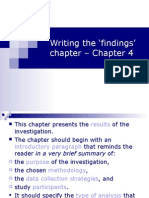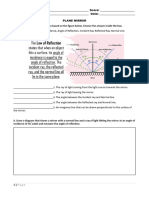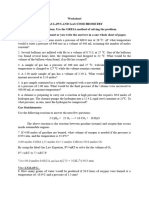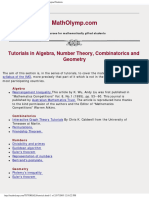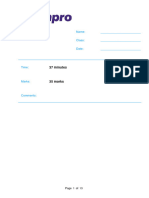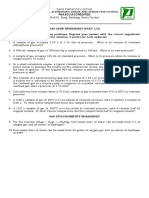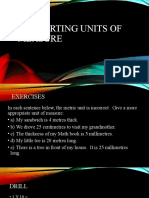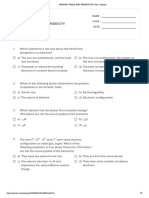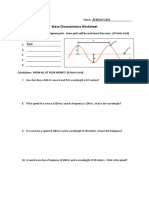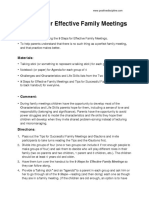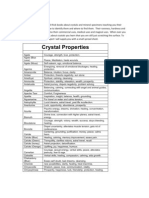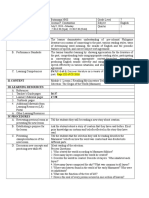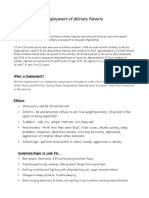Obs Inf Worksheet 2013
Obs Inf Worksheet 2013
Uploaded by
api-338002331Copyright:
Available Formats
Obs Inf Worksheet 2013
Obs Inf Worksheet 2013
Uploaded by
api-338002331Original Title
Copyright
Available Formats
Share this document
Did you find this document useful?
Is this content inappropriate?
Copyright:
Available Formats
Obs Inf Worksheet 2013
Obs Inf Worksheet 2013
Uploaded by
api-338002331Copyright:
Available Formats
P a g e |1
Name_________________________________________
Observation Inference Prediction
Purpose: To practice distinguishing between observations, inferences and predictions.
Scientists spend a great deal of time observing the natural and built world. When a scientists observes he or
she takes in information using the five senses. Often tools such as microscopes are used to extend the senses
and make the observations more precise and accurate.
Observations may be qualitative or quantitative. Qualitative observations are those that describe qualities,
properties or characteristics of objects or phenomena. Color, texture, smells, sounds are all examples of
qualitative observations. Quantitative observations are those that can be measured in numbers. Mass,
volume, speed, temperature are a few examples. Tools are often used to make quantitative observations.
Observations in science should always be facts (a statement that can be proven true or false), not opinions (an
expression of a persons feelings that cannot be proven).
Observations lead to inferences. An inference is an educated guess or reasonable conclusion drawn from the
observation. It is a possible explanation for the observation.
Predictions can be made from inferences. A scientific prediction is an educated guess about a future event. It
can be made without knowing whether it is correct; it may be an incorrect guess. Thats ok. Scientists learn
from incorrect guesses as much as correct ones.
For example, a student wakes up to thunder one morning.
He may observe the thunder using his sense of hearing, he made a factual, qualitative observation.
The sound of the thunder led to the inference that it was raining it might not have been raining.
The student then predicted that they would not go outside during school that day because of the rain.
Look at the photo below and use it to make one observation, one inference and one prediction:
Observation ___________________________________
___________________________________
Inference ___________________________________
___________________________________
Prediction ___________________________________
___________________________________
M. Poarch 2013
science-class.net
Permission granted to copy for non-profit, educational use only.
P a g e |2
Read the following sentences carefully. Identify if the sentence is an observation (O), an inference (I) or a
prediction (P). Record your answer on the line to the left of the sentence.
1._____
It must have rained because the grass is wet.
2._____
It is 95 degrees today.
3._____
Today is Friday, so I think we will have fish sticks in the cafeteria for lunch.
4._____
The fish swim to the top of the aquarium when I come near.
5._____
The fish expect food when I come near the aquarium.
6._____
The river is flowing very fast.
7._____
The blowing sand in the desert will wear away the rocks.
8._____
The mountain is making rumbling noises deep inside.
9._____
The mountain is a volcano.
10.____
The volcano is going to erupt soon.
M. Poarch 2013
science-class.net
Permission granted to copy for non-profit, educational use only.
You might also like
- Abstract Reasoning TestsDocument26 pagesAbstract Reasoning TestsNicoleta67% (6)
- Physical Science 20 - Unit PlanDocument11 pagesPhysical Science 20 - Unit Planapi-349567441100% (1)
- Writing The Findings' Chapter - Chapter 4Document8 pagesWriting The Findings' Chapter - Chapter 4api-3696879100% (3)
- 4.1 KD Handbook v2.12 FinalDraftDocument47 pages4.1 KD Handbook v2.12 FinalDraftYves FabiolNo ratings yet
- 4-1 06 Lahav - Quest For WisdomDocument14 pages4-1 06 Lahav - Quest For WisdomarabelmNo ratings yet
- Grade 10 Tasks 2nd Q - A4 PaperDocument6 pagesGrade 10 Tasks 2nd Q - A4 PaperAlison Gicalde GandiaNo ratings yet
- Periodic Classification of Elements: Multiple Choice QuestionsDocument10 pagesPeriodic Classification of Elements: Multiple Choice QuestionsAryanNo ratings yet
- Enthalpy Change WorksheetDocument3 pagesEnthalpy Change WorksheetChemist Mohamed MohyNo ratings yet
- Chapter 1Document3 pagesChapter 1Yu Ae LiNo ratings yet
- Worksheet Velocity GraphDocument2 pagesWorksheet Velocity GraphFehmeed AlchemyNo ratings yet
- Math 10-3 Unit 1.4 Worksheet - Sales 2018-19 STUDENTDocument4 pagesMath 10-3 Unit 1.4 Worksheet - Sales 2018-19 STUDENTBob SmynameNo ratings yet
- PT 1 - Thermochemistry (Spontaneity, Entropy, Enthalpy, Gibbs Free Energy)Document5 pagesPT 1 - Thermochemistry (Spontaneity, Entropy, Enthalpy, Gibbs Free Energy)jayjay.miloNo ratings yet
- 4.04 Modelling Linear Functions - WorksheetDocument14 pages4.04 Modelling Linear Functions - WorksheetJamesNo ratings yet
- Worksheet On GAS LAWS and STOICHIOMETRYDocument2 pagesWorksheet On GAS LAWS and STOICHIOMETRYKenneth ComabigNo ratings yet
- Acids and Bases Review Packet - KEYDocument11 pagesAcids and Bases Review Packet - KEYMichelle Samayoa100% (1)
- Animal ClassificationDocument2 pagesAnimal ClassificationTarshaCNo ratings yet
- Ecology Lesson Plan 1Document4 pagesEcology Lesson Plan 1Michael Van EttenNo ratings yet
- Worksheet: Math Grade9 Marks 15 Linear Function Plotting & Graphing Section1Document4 pagesWorksheet: Math Grade9 Marks 15 Linear Function Plotting & Graphing Section1200832734No ratings yet
- GAS LAWS - WorksheetDocument1 pageGAS LAWS - WorksheetJhun Lerry TayanNo ratings yet
- Acid-Base Unit Review Questions Answer KeyDocument3 pagesAcid-Base Unit Review Questions Answer KeySamia KabirNo ratings yet
- Chemistry Entrance Test 2Document3 pagesChemistry Entrance Test 2Eljesa LjusajNo ratings yet
- Inductive and Deductive ReasoningDocument16 pagesInductive and Deductive ReasoningCedrick Nicolas Valera0% (1)
- Chemistry Final WorksheetDocument14 pagesChemistry Final Worksheetz sNo ratings yet
- Scientific Attitude and Values: Francis John V. SicosanaDocument17 pagesScientific Attitude and Values: Francis John V. SicosanaeselNo ratings yet
- Alcohol, Ether, Phenol WorksheetDocument22 pagesAlcohol, Ether, Phenol WorksheetSDMNo ratings yet
- G = Δh - Tδs: Spontaneity and Gibbs free energyDocument4 pagesG = Δh - Tδs: Spontaneity and Gibbs free energyAdufe RufaiNo ratings yet
- Reading Comprehension Worksheets For Grade 1Document6 pagesReading Comprehension Worksheets For Grade 1sahrish.khan23No ratings yet
- Chemistry Mock Test 12: ExamraceDocument9 pagesChemistry Mock Test 12: ExamracepremkumarNo ratings yet
- Alcohols, Phenols & Ether - QuestionsDocument8 pagesAlcohols, Phenols & Ether - QuestionsK. RupaNo ratings yet
- Worksheet 4 Plane MirrorsDocument3 pagesWorksheet 4 Plane MirrorsJoseph Lee100% (1)
- Test Bank For Organic Chemistry 11th Edition Francis Carey Robert Giuliano Janice SmithDocument31 pagesTest Bank For Organic Chemistry 11th Edition Francis Carey Robert Giuliano Janice Smithupsahu100% (1)
- Tutorials in Elementary Mathematics ForDocument84 pagesTutorials in Elementary Mathematics ForAashray KumarNo ratings yet
- Worksheet On Newtons Law of MotionDocument10 pagesWorksheet On Newtons Law of MotionLalaine MamaedNo ratings yet
- Physics Waves WorksheetDocument3 pagesPhysics Waves WorksheetRizky HermawanNo ratings yet
- Quantitative Ability: (Practice Exercise-III)Document68 pagesQuantitative Ability: (Practice Exercise-III)NimishaNo ratings yet
- Inference Observation Worksheet 2Document3 pagesInference Observation Worksheet 2Clarissa Cuña0% (1)
- Hess - S Law Pack 1Document13 pagesHess - S Law Pack 1bilaalquadriNo ratings yet
- Periodic Table Worksheet #1Document3 pagesPeriodic Table Worksheet #1kfgbkNo ratings yet
- Solving Systems of Linear Equations WorksheetDocument5 pagesSolving Systems of Linear Equations Worksheetapi-491086227No ratings yet
- Major Branches of Biology. With Ans For Student PDFDocument2 pagesMajor Branches of Biology. With Ans For Student PDFSanjay dasNo ratings yet
- Unit Conversions WorksheetDocument3 pagesUnit Conversions WorksheetMaryum HassanNo ratings yet
- Gas Laws WorksheetDocument1 pageGas Laws WorksheetNony ManaliNo ratings yet
- Unit 4: Dynamics: Newton's Laws of MotionDocument22 pagesUnit 4: Dynamics: Newton's Laws of MotionDandy H HerkoNo ratings yet
- Converting Units of MeasureDocument16 pagesConverting Units of MeasureRyle SentillanosaNo ratings yet
- Free Complementary and Supplementary Angles WorksheetsDocument15 pagesFree Complementary and Supplementary Angles WorksheetsmustafasyedasifNo ratings yet
- English Non Verbal Figure Formation AnalysisDocument11 pagesEnglish Non Verbal Figure Formation AnalysisParesh ModiNo ratings yet
- ThermochemistryDocument25 pagesThermochemistrydanielmahsa100% (1)
- 4.7 Intermolecular ForcesDocument5 pages4.7 Intermolecular ForcesrachpNo ratings yet
- 19th PMO National Stage Oral PhaseDocument9 pages19th PMO National Stage Oral PhaseChantelle EstarisNo ratings yet
- Periodic Table and Periodicity - Print - QuizizzDocument5 pagesPeriodic Table and Periodicity - Print - QuizizzIzzatiNo ratings yet
- Earth Science REVIEWERDocument16 pagesEarth Science REVIEWERZei LandichoNo ratings yet
- Biochemistry 8th Edition Campbell Test BankDocument16 pagesBiochemistry 8th Edition Campbell Test Banktolentinoi401No ratings yet
- P5 Science - Air and Respiratory System Concept Revision SheetDocument2 pagesP5 Science - Air and Respiratory System Concept Revision SheetAnnalashimiNo ratings yet
- Waves WorksheetDocument3 pagesWaves WorksheetSaima HoqueNo ratings yet
- Inhalation and ExhalationDocument1 pageInhalation and Exhalationbatool kharoufNo ratings yet
- Tell Whether Each Is A Solid, Liquid, or Gas. Tell Whether Each Is A Solid, Liquid, or GasDocument2 pagesTell Whether Each Is A Solid, Liquid, or Gas. Tell Whether Each Is A Solid, Liquid, or GasGuillermo Cordova100% (1)
- Classification of Organic CompoundsDocument7 pagesClassification of Organic CompoundsGrace L. AmorNo ratings yet
- Entropy, Enthalpy, Gibbs Free EnergyDocument15 pagesEntropy, Enthalpy, Gibbs Free EnergyPatrick Antonio Orge ChingNo ratings yet
- Chemical Kinetics LectureDocument22 pagesChemical Kinetics LectureMohamed MegahedNo ratings yet
- Homework Assignments Chapter-6: Alkyl Halides-Substitution and Elimination ReactionsDocument14 pagesHomework Assignments Chapter-6: Alkyl Halides-Substitution and Elimination ReactionsandrewNo ratings yet
- Wave Characteristics Worksheet 2020-04-13 21 - 47 - 49 PDFDocument2 pagesWave Characteristics Worksheet 2020-04-13 21 - 47 - 49 PDFJoshua LaraNo ratings yet
- Kinetics Multiple Choice and Free Response With KeyDocument29 pagesKinetics Multiple Choice and Free Response With KeyPatrícia Cardoso GonçalvesNo ratings yet
- Observing and Inferringdocx 2Document3 pagesObserving and Inferringdocx 2kristen chenowethNo ratings yet
- Marikina Science High School: Learning TargetsDocument2 pagesMarikina Science High School: Learning TargetsMark Anthony CasimiroNo ratings yet
- Ted HughesDocument5 pagesTed HughesAnca-IoanaNo ratings yet
- The Political Unconscious (1) .Doc2Document13 pagesThe Political Unconscious (1) .Doc2Mohammed Jhilila100% (2)
- Tapas PowerpointDocument20 pagesTapas Powerpointapi-297583834No ratings yet
- Lemon TreeDocument3 pagesLemon TreeSuriaati Hartini SairunNo ratings yet
- Pat CvfinalDocument2 pagesPat Cvfinalapi-431060086No ratings yet
- Twelve: © 2007 Prentice Hall Inc. All Rights ReservedDocument55 pagesTwelve: © 2007 Prentice Hall Inc. All Rights Reservedniveditha_murugesanNo ratings yet
- Introduction To PragmaticsDocument13 pagesIntroduction To PragmaticsMada AnandiNo ratings yet
- Powerpoint Project "All About Me": Requirements For The PresentationDocument2 pagesPowerpoint Project "All About Me": Requirements For The PresentationJIM GUIMAC100% (1)
- The Subtle Art of Not Giving A Fuck - by Mark Manson - Derek SiversDocument11 pagesThe Subtle Art of Not Giving A Fuck - by Mark Manson - Derek Siversfatank040% (1)
- Lesson 1: "Following The MAP"Document16 pagesLesson 1: "Following The MAP"varshasriNo ratings yet
- Bakhtin Discourse in A NovelDocument12 pagesBakhtin Discourse in A NovelAl Fatima Trust100% (1)
- 9 Steps For Effective Family Meetings: ObjectivesDocument4 pages9 Steps For Effective Family Meetings: Objectiveszyz777No ratings yet
- For and Against EssaysDocument14 pagesFor and Against EssaysTeodora Mihaela100% (1)
- The Singing BirdDocument2 pagesThe Singing BirdsakuraleeshaoranNo ratings yet
- First Mid Term Exam in Oral CommunicationDocument2 pagesFirst Mid Term Exam in Oral CommunicationRustomGatonNo ratings yet
- For RRLDocument6 pagesFor RRLkaela mae pimentelNo ratings yet
- CrystalsDocument4 pagesCrystalsMarieta StevensNo ratings yet
- Week 5 July 6, 7, 8, 9, and 10Document16 pagesWeek 5 July 6, 7, 8, 9, and 10Josenia Constantino50% (2)
- Performance Management: Robert L. Mathis John H. JacksonDocument40 pagesPerformance Management: Robert L. Mathis John H. JacksonpritiNo ratings yet
- Who Is A PoetDocument11 pagesWho Is A PoetShirin Afroz91% (11)
- Structuralism, Semiology, and CultureDocument20 pagesStructuralism, Semiology, and CultureBianca DarieNo ratings yet
- Guidance Final ProjectDocument3 pagesGuidance Final Projectapi-270068089No ratings yet
- The Negative ColorsDocument2 pagesThe Negative ColorsFarokh Shahabi NezhadNo ratings yet
- Unit III Set Up Time Reduction, TQM, 5s, VSMDocument54 pagesUnit III Set Up Time Reduction, TQM, 5s, VSMsaravanan SaranNo ratings yet
- What Is Philosophy of Education2Document2 pagesWhat Is Philosophy of Education2Kamarul KhamisNo ratings yet
- Sons and Lovers 1Document35 pagesSons and Lovers 1Harinder Singh Hundal100% (1)


